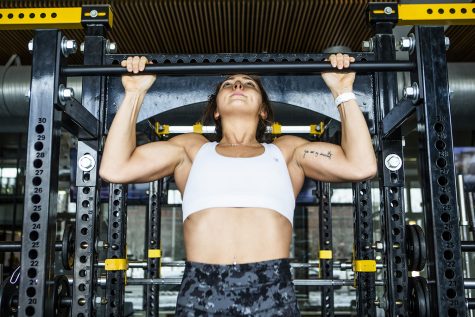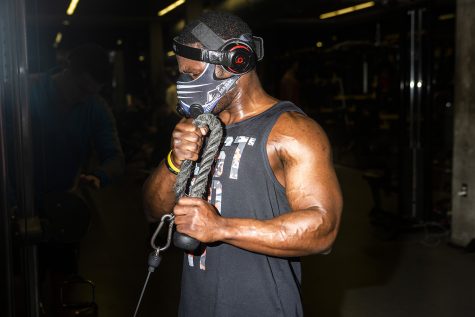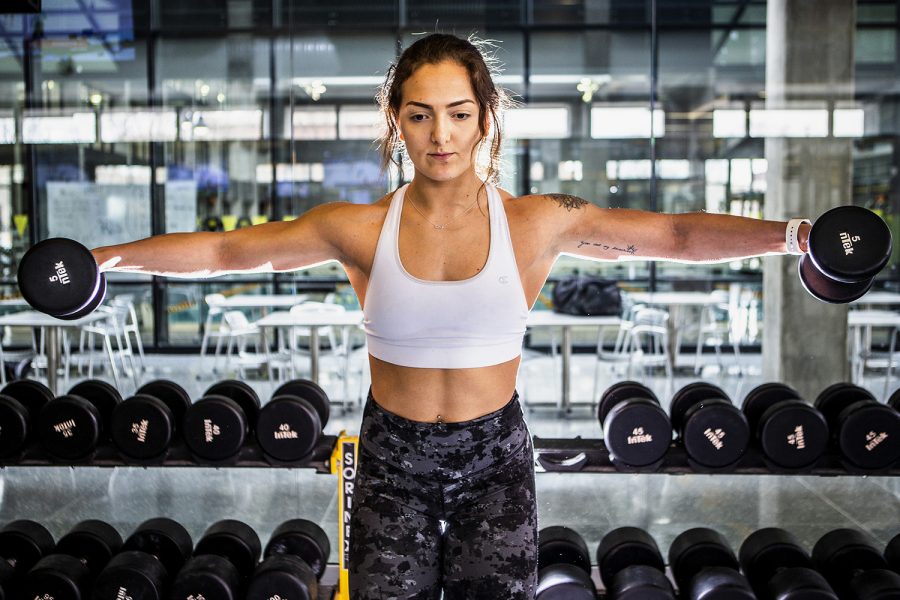Into the world of weightlifting: cutoffs, hoodies, and breaking gender roles
While on its surface, weightlifting may seem like a boy’s club, the reality is vastly different.
Camille Lazzarotto lifts weights at the CRWC on Wednesday, March 6, 2019. Lazzarotto is an athletic trainer at the recreation center and works out in-between the times she has clients.
March 6, 2019
Loud, clanking metal weights shake the ground. Gym goers lift gargantuan-sized plates above their heads, threatening to collapse under the intense pressure any second. They wear black or gray jogger shorts, Nike tennis shoes, and homemade cutoffs. Faces contort in a strange mixture of pain, anger, and self-determination.
For weightlifters and bodybuilders, the culture around achieving a strong body is often male-centered. While time spent at the gym can serve as an escape from school or somewhere to socialize, “gettin’ swole” is almost always seen as a male-driven world. However, there is a strong standing in the weightlifting community that is female.
Walking into the University of Iowa Campus Recreation & Wellness Center, the first-floor weightlifting area may seem like a boys’ club.
RELATED: Iowa City Olympic Weighlifting Club brings strength to the city

Camille Lazzarotto lifts weights at the CRWC on Wednesday, March 6, 2019. Lazzarotto is an athletic trainer at the recreation center and works out in-between the times she has clients.
“On the first floor, you get your mix between gym bros, which are the guys who clearly work out and seem to know what they’re doing and also the guys who have no idea what they’re doing,” UI senior Matt Buhr said. “It’s interesting because each floor has its own posse.”
UI senior Brittany Larson also said she notices a particular difference demographically in where people are and what they’re doing at Campus Rec.
“It’s almost always male [weightlifters] in the show areas. If you go to the area where they’ve got the big windows, it’s almost always male,” she said. “[Women] almost always do the more inner concepts. If it’s showboating, it’s definitely male. But as you go up into the cardio, respiratory fitness levels, like running, that’s more of a female aspect.”
Larson said many stereotypes are perpetuated in the world of fitness.
“With the way society is and the way everybody judges one another, I feel like men have to be muscular and built, which definitely is not true,” she said. “That’s the way people are perceived and pushing it. A lot of women don’t do [weightlifting] because they want to stay petite.”
These societal expectations can hinder women’s ability to perform at their best.
Certified personal trainer Andrea Parkinson said she makes an effort to be more encouraging of other women.
“When it comes to female-to-female weightlifting, it’s more encouragement and talk-up, and there’s no judgment, really. We’ll make improvements, we’ll steadily increase,” she said. “I feel when it’s a female and a man, women get a lot of judgment, or they’re looked down upon for how much they can lift. It’s not a big female-related sport. It’s very awkward because you feel like you’re judged; you’re looked down upon. It’s a lot of negative downplay on [female weightlifting].”
There are certainly negative stereotypes perpetuated regarding women, but UI senior and certified personal trainer Camille Lazzarotto identified one regarding men as well.
“I feel like the biggest stereotype is the biggest guys have really big egos and they’re full of themselves, but when you get to know them, they’re some of the most humble people you’ve ever met,” she said. “It’s more of dedication and lifestyle that they want to lead, and it’s just their preference on how they want to look rather than egocentrism.”
Parkinson said that in addition to hurtful stereotypes, women might avoid the gym because of sexual harassment.
“Definitely more males try to pick up women at the gym, and I’ve been a subject to that, which is uncomfortable,” she said. “I’ve come here to work out myself, and it doesn’t matter what I’m wearing or what I look like, it doesn’t mean that I’m here to meet men. Fitness has been sexualized so much that a lot of sexual harassment has come out of it.”
Parkinson said she’s witnessed harassment at the gym firsthand.
“I’ve caught people taking pictures of me or other people,” she said. “I’ve been interrupted in the middle of training a client and somebody asking me if I could start training them and what’s my number. [Sexual harassment] happens all the time.”
The threat of harassment and intimidation at the gym has led women to avoid weight areas and often congregate around other areas.
“Women feel uncomfortable. You’re gonna find more women doing cardio machines because they feel comfortable with that,” Parkinson said. “That solely comes from the culture in which we’ve developed and grown up in. I think that’s changing now that the next generation is coming up. Lifting weights is becoming more female-friendly.”

Dady Mansaray works out at the CRWC on Monday, March 4, 2019.
Parkinson started the first all-female weightlifting class at Campus Rec.
“It started off kind of slow. It took off and still goes on today,” she said. “Making sure that there’s something special for women has been beneficial because they feel more included. I think that’s been very helpful, giving them the tools so that they can do stuff on their own. Not everyone can afford a personal trainer.”
UI fitness instructor Cody Schlitter, who teaches weightlifting classes at the Field House, said weightlifting can offer a lot for every lifter, regardless of gender.
“It’s very important for long-term health,” he said. “Anyone can do this; there are no requirements. You don’t have to lift a certain amount of weight. We all want to live a high-quality life, regardless of who you are, male, female, young, old, no experience, experience, whatever it is. Everyone should benefit.”
Despite stereotypes, Schlitter believes a community of weightlifters varies depending on where they are. In fact, he said that his Intro to Weight Training class is more female than male and overall, weightlifting culture is improving in encouraging diversity.
“To truly understand a culture, you have to be in it,” he said. “For people who aren’t exposed to [weightlifting] culture, might have the perception of a more guy-related thing and testosterone-driven, which isn’t true, or at least it shouldn’t be true. It probably is in some places, so I understand that aspect, but it doesn’t have to be the case.”
Despite the intimidating aspects, there are lifters in the gym trying to create a culture of support for new and old lifters alike.
“Instead of being ashamed of a girl having muscle, I feel like it’s becoming more accepted,” Lazzarotto said. “It’s not just us in general, but I feel like as a nation and a generation, we’re becoming more inclusive of every body type, every shape, every size, every color, just normalizing that.”
UI senior and avid weightlifter Dady Mansaray believes that through community support, all people can reach their potential.
“When I see [other lifters] performing a type of specific exercise and not doing it correctly, I try to go out of my way and help them,” he said. “Sometimes, people feel a little intimidated by that, but I try to do it in a way that makes them feel like this is just me encouraging them, not me trying to put them down.”
Mansaray said he wants to build a fitness empire in Iowa City.
“I have made it my mission to be engaged with members of this community. I’ve been seeing people doing the same, trying to be engaged with other students,” he said. “What we have at the weightlifting environment is pretty positive. People are pretty friendly, pretty helpful.”
Mansaray said those in the weightlifting community support each other, offering tips and feedback to less-experienced individuals.
Buhr agreed it is common to help other lifters in the gym.
“I’ve been approached with this, so I’ll approach other people saying, ‘Hey, can I give you a tip?’ instead of saying, ‘You should do it this way.’ They can say no, and that’s fine,” he said. “The one reason everybody’s here is to better themselves in one way or another, and it’s just a matter of what level everybody is on.”






